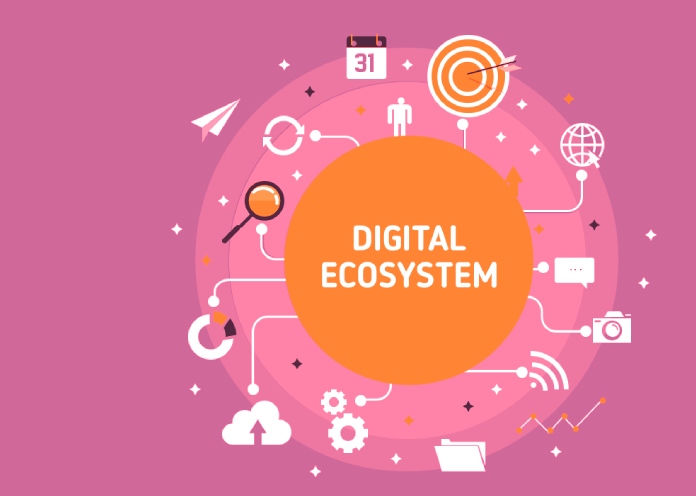What Is The Company’s Digital Ecosystem, And What Services Are Included?

What Is A Digital Ecosystem?
What Is The Company’s Digital Ecosystem: An ecosystem is a system that unites all living organisms and their interaction with nature and among themselves. But the word “digital” tells us that we are not talking about living spirit. Let’s move to the digital world.
A digital ecosystem is a system that unites all elements of a digital platform and their interaction with each other and with the outside world. Elements of such a system can be a single account, many digital services that perform different tasks, a server infrastructure, a team of developers and engineers, customers and shareholders, and interested people.
Digital Ecosystem Example: Amazon
Google, Apple, and Amazon have created striking examples of such ecosystems. What Is The Company’s Digital Ecosystem In the Russian market, the ecosystem approach is used by Yandex and Sberbank.
Let’s take a look at Amazon as an example of how their digital ecosystem has evolved. Since about 2000, the company began building server infrastructure worldwide to serve the customers of its online store. Amazon soon began leasing server capacity to other companies, leading to the Amazon Web Services (AWS) platform.
This step was an important milestone in creating the ecosystem that they have now. Amazon used AWS as a launching pad for its other services, such as Amazon Prime Videos, Prime Music, Studio, and more.
This is how the Amazon universe was born, which quickly gained popularity worldwide and provided its subscribers with certain benefits on all sites. Subscribers received packages faster, had access to Amazon Music, and could even watch TV shows and movies from the main library. Now Amazon has more than 40 subsidiaries and constantly attracts new projects to its ecosystem.
Ecosystems in living nature are characterized by self-organization, scalability, and sustainability. By creating similar systems in numbers, people strive to give them the same qualities.
Scaling. Amazon was able to grow precisely because it had server capacity and digital infrastructure worldwide.
Self-organization principle. Each company within the Amazon corporation has its team, which decides how and where to develop, what is new to add.
The principle of sustainability. What Is The Company’s Digital Ecosystem The company works with different target audiences, solves other people’s problems, and constantly develops new services and services. This means that if there is less demand in one area, the company can quickly switch to another, making a profit. Thus, the company will resist and even develop even in times of crisis.
In addition, the company builds loyal relationships with customers, offers bonuses when using several platform services. This also adds stability to the company.
The Challenge Of The Digital Ecosystem
The digital ecosystem helps support the client at all stages of his life cycle, sell additional products, services, and services, and solve his problems. In general, it becomes practically his best friend in daily shopping.
All digital tools in the ecosystem are tailored to perform an important function – to improve the quality of customer service and extend the time of cooperation with them (LTV). In turn, this leads to an increase in the company’s profit for the entire period of collaboration with this client.
How can digital tools be integrated into the customer journey on the site? For example, we conducted a study for one large Russian automotive holding in which we distributed actual and potential online services across all stages of working with a client. Such a scheme helps to understand where the ecosystem can be further developed (we provide this service to clients as part of the web site’s technical support).
The process of working with a client in the car market can be divided into two large stages: sale and after-sale service. These stages, in turn, are divided into sub-stage.
We can accompany each sub-stage of the sale and each service with online services. In addition, each online service is aimed at solving one of the critical tasks (in the diagram below, this is marked with multi-colored squares):
Conversion Rate Boost, such as car model comparison and benefit calculator.
Reducing the cost of driving traffic (User Acquisition), for example, SEO site optimization, detailed catalog, a blog with car reviews.
Increase the launch speed of products, for example, a design system and a media portal.
Supporting infrastructure projects, such as various constructors and automation.
The list of tasks can be expanded depending on your goals. If you have created a website for brand development, it will be essential for you to track audience engagement metrics. And develop services that will affect this indicator.
Types Of Ecosystems
Based on our work experience, we have identified several types of ecosystems:
Horizontal. Selling products by various independent suppliers. Example: market places.
Vertical. The company manufactures products and provides them to customers themselves. Example: Sberbank ecosystem.
Hybrid. Symbiosis of horizontal and vertical models. Selling your products + offering additional services from partners (for example, in the field of car sales, this can be credit/leasing / technical assistance and evacuation, etc.).
Also, the ecosystem can be divided into internal – for the needs of employees and improving business processes and external – for solving problems in the external environment: sales, PR, working with investors and partners.
What Services Can Be Included In The Ecosystem Of Sites?
There are no clear criteria for what should be included in the ecosystem. But there are some best practices that we suggest looking at in the automotive industry.
What may relate to the auto brand ecosystem:
External
Media portal
Marketplace for manufacturer
HR portal
Online services (calculators, configurators, online purchase, registration, etc.)
Product sites
Dealer sites, dealer platform
Landing page
builder Lead form builder
Internal
Design system
Product Information Management
Media portal
Autotests
Automation of business processes
Further, we propose to consider several online services with specific examples.
Media Portal
A media portal or media storage (internal and external) is a centralized storage of essential media data (photos, videos, etc.), which ensures internal and external consistency of all brand content and maintains its relevance and quality.
Media Storage Functions:
- Provides access to the necessary content at any time.
- Supports brand values and positioning.
- Helps broadcast only relevant news or product experiences.
- Reduces the time spent searching and transferring materials.
- It helps to quickly equip dealers with the necessary materials for marketing campaigns, filling sites, and announcing new car models.
- Allows you to control access to content and track what media has been uploaded, by whom, and in what way.
The media portal is mainly intended for four types of users. What Is The Company’s Digital Ecosystem Employees and company management can quickly post or find information on the company’s products (in the car market, these are new car models), create collections of materials on the topic, and track the number of downloads and views.
There Are Also External Users:
- dealers will be able to access the new content quickly and, on its basis, create selling materials for themselves;
- The media will take high-resolution photos and quickly get the latest company news;
- Contractors will receive all the necessary photos, videos, and guides to develop branded materials.
Product Information Management
Another helpful service in the ecosystem of sites is the Product information management system (PIM system). What Is The Company’s Digital Ecosystem It is a centralized system for storing marketing information about its products, their technical descriptions, photographs, sales data, etc.
You might wonder how PIM differs from media storage? Indeed, they are similar in many ways. The main difference is that PIM is designed to work with sales channels and customers, so it stores basic information about products and media and sales data, customer contacts and preferences, and supplier data. It can also automatically exchange data with marketplaces and other electronic trading platforms.
When Is PIM Needed? As The Company Grows, The Following Problems May Arise:
- Data is distributed across different systems and employees – there is no single repository.
- A lot of time is spent looking for reliable information, proofreading, and checking.
- A long process of publishing data is a long chain of transfer between the participants.
- The need to regularly update data on multiple channels, lack of automation.
PIM can help save time finding and disseminating the correct information, eliminate inconsistencies across channels, and increase the efficiency and speed of the marketing department and the process of bringing new products to market.
Benefits Of PIM
- All data in one place.
- Saving time by automating work with data, the absence of routine manual operations for entering, updating, and distributing through sales channels.
- Confidence in the quality, reliability, and relevance of information about products, avoiding mistakes at subsequent stages of business processes.
- We simplified product navigation by building hierarchies and relationships, managing attributes.
- They reduce the cost of content, rational use of resources, and operating costs.
- Increase customer satisfaction and sales through high-quality data and consistent information across all touchpoints.
- Reduced time to market for new products, rapid promotion, and expansion of sales channels due to possible integration with partners, marketplaces.
- Productive work of partners – there is no need to wait for information from the marketing department. All product data is available in the PIM system.
Examples Of
Audi uses PIMto make accessory information available worldwide in 18 languages. The data is intended for internal work processes and distributors, suppliers, and end-users.
BMW Group North Europe uses PIM to quickly manage their 40 highly-attributed products in 7 markets and five languages.
Eberspächer Is an international supplier of car parts. We launched a PIM-based dealer portal, which provides information on more than 10,000 products in 31 languages (technical bulletins, brochures, catalogs, marketing information).
Design System
A design system is a holistic visual language and its technical reflection in a library of components and accompanying templates. What Is The Company’s Digital Ecosystem It helps to achieve consistency between design and code: each component or design pattern has a specific code pattern associated with it. As a result, strategy can scale in parallel with development.
Elements Of The Design System:
- Brand book
- UI Kit
- Design components implemented in the code
- A description of the principles of operation
- Rules for using style elements and components
The design system also helps you understand how a product’s design works. Various companies have published design systems, including Uber, Apple, Slack, Figma. If you are interested in the content and details, you can download them to Figma and study.
When A Design System Is Needed:
- If you have many digital products: grocery sites, many landing pages, promo sites, a dealer platform, etc. Other product launches are planned.
- All products are constantly being developed and updated, which takes time and resources.
- Often, various products, promotional landing pages, and other landing pages are launched concisely.
- Different contractors carry out development. In this case, various design components can be created to solve the same problems, and the principle of uniformity is violated. We need a unified design base.
- From a development point of view, there are no uniform regulated rules for working with design components, which entails an increase in the number of bugs and labor costs for testing and debugging.
How Does The Design System Help To Solve These Problems?
Due to uniform rules, it is possible to reduce the cost and timing of developing and updating digital products. What Is The Company’s Digital Ecosystem New participants delve into the process faster. In general, there is more order and consistency, and there are fewer bugs—no need to waste time creating components from scratch. You can use ready-made templates. This approach helps get the product to market and offer it to users as quickly as possible (MVP approach) and increases brand awareness.
Uber’s Design System
Uber is known for its revolutionary approach. The company also developed its design platform to create a consistent user experience for its many products.
The Uber Brand Guidelines cover nine elements: logo, color, composition, iconography, illustration, animation, photography, tone of voice, and typography.
In addition to providing visual and stylistic guidance, Uber has also created Base Web, an open-source UI component library. It includes typography, color, grid, buttons, lists, and controls. The system is flexible and customized depending on the tasks while maintaining brand consistency.
Online Services
Car dealers use many online tools to help the user choose a car from the comfort of their home. And all of these online tools can also become part of your digital ecosystem. Each stage of the online shopping process has its own set of services.
These brands generally have a very clever buying process and have tried and paid a lot of attention to the user journey. As a buyer, you can go through all the stages, from booking with online prepayment to full online payment for a car and insurance on the website.
Also Read: Five Myths About Website Development Using The Tilda Website Builder. Upload Cases




